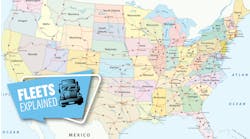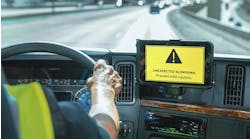Law enforcement officers will be on the lookout next week, July 12 through 18, for commercial vehicle drivers and passenger vehicle drivers engaging in dangerous driver behaviors as part of the Commercial Vehicle Safety Alliance's (CVSA) Operation Safe Driver Week. Such dangerous behaviors include speeding, distracted driving, failure to use a seatbelt, following too closely, reckless driving, drunk or drugged driving, and more.
Drivers behaving in a dangerous manner will be pulled over by law enforcement and may be issued a warning or citation. Such citations, however, can be avoided by taking simple measures before going on the road.
“It's really about doing a proper pre-trip,” said Fred Fakkema, vice president of safety and compliance at Zonar. “By doing a really good pre-trip inspection before a driver leaves, they can already be in that safety mindset. Don't just pencil it in. Make sure to walk around the entire vehicle to ensure every part of that vehicle is working properly because it only takes one small low-hanging fruit to cause a bigger spiral.”
As a state trooper for over 25 years, Fakkema knows exactly what law enforcement officials look out for while on the road.
“It's all the simple stuff that enforcement looks for,” Fakkema continued. “It's the turn signal not working. It's the headlight network versus amber lights not working. No mud flaps, no seatbelt – all those simple things can draw the person to that vehicle.”
Fakkema urged the importance of keeping an eye out for speed limit changes, especially in construction zones, where multiple reduced speed requirements can quickly become dangerous if a driver is speeding or distracted. Staying vigilant can become a simple measure to prevent such accidents.
“Cruise control. People don't talk enough about cruise control for a commercial vehicle,” Fakkema added. “Using cruise control not only is proven to save fuel, but it also keeps the driver inside the speed limit. Keeping an eye out for speed limit changes, especially in construction zones, can help the driver stay alert on the road.”
According to the National Highway Traffic Safety Administration (NHTSA), in 2018, 9,378 people died in speed-related casualties – equally 25% of all roadway fatalities that year. Fortune states that national data shows even a 10-mph speed increase ups the risk of a crash by 9.1%.
As the number of vehicles on roadways decreased in March and April, average speeds measured during the first week of April increased significantly in the five largest U.S. metropolitan areas. According to recent data, the average speed on interstate highways, state highways and expressways in those areas increased by as much as 75% compared to January and February.
- New York City: Transportation officials reported an increase of more than 60% in the number of speed camera tickets issued in March compared to a year ago. At the same time, traffic was down more than 90% compared to January.
- Washington, D.C.: Traffic decreased 80% in March compared to January, while officials recorded a 20% increase in March speeding tickets. Of those tickets, violations for driving 21-25 mph over the speed limit rose by nearly 40%.
- Toronto, Canada: Over just one weekend, police charged 18 drivers with stunt driving, with speeds of 80-106 mph on the Don Valley Parkway, a major freeway that’s limited to 55 mph.
- California: An increase in speeding violations was reported, and although the California Highway Patrol’s call volume has decreased, the crashes they have recently responded to have been worse.
- Tucson: Tucson Police reported a 40% increase in one-vehicle wrecks, which usually happens when a driver’s going so fast they lose control.
- Minnesota: Motor vehicle crashes and fatalities more than doubled compared to the same time period in previous years. Half those deaths were related to speeding or careless or negligent driving.
- Colorado, Indiana, Nebraska and Utah: Police have clocked highway speeds of more than 100 mph.
- Chicago and Los Angeles: Travel speeds increased from 35-38% above average to 74-75% above average in just one week.
“As passenger vehicle drivers are limiting their travel to necessary trips and many commercial motor vehicle drivers are busy transporting vital goods to stores, it’s more important than ever to monitor our roadways for safe transport,” said John Samis, president of CVSA.
Historically, drivers’ actions have contributed to 94% of all traffic crashes, according to the National Highway Traffic Safety Administration (NHTSA) Traffic Safety Facts report. And although NHTSA’s 2018 highway crash fatality data showed a 2.4% decline in overall fatalities, the number of fatal crashes involving large trucks increased by 0.9%.
“In 2020 through June, there have been over 139,000 moving violations, most of them are for speeding, following too close and improper lane change,” Fakkema stated. “But one of the interesting ones that's on the list is using the cell phone – over 9,000 have been cited so far this year with nearly 500 of them for texting.”




